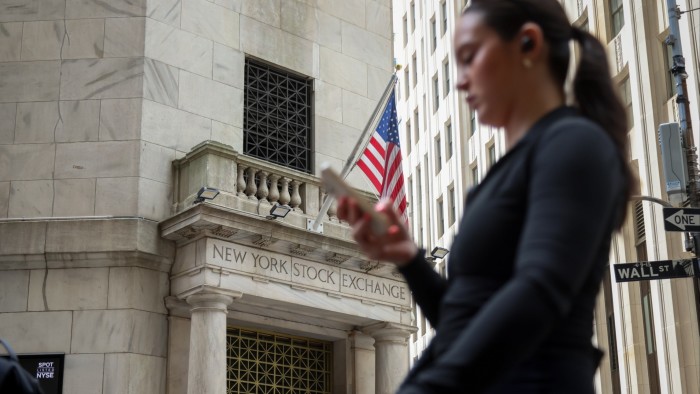The dumping of US assets in favour of Europe’s resurgent markets signals the start of a much longer-term move by pension funds and other big institutional money managers to cut back their huge exposure to dollar investments, say investors.
Wall Street banks say they are seeing signs that investors managing trillions of dollars of assets are starting to trim their US positions, on concerns over erratic policymaking, President Donald Trump’s attacks on the Federal Reserve chair and the fallout from the trade war.
Although US stocks have almost recovered their losses since Trump’s so-called “liberation day” tariff announcements rocked global markets last month, they remain in negative territory this year and behind global peers. The dollar is down more than 7 per cent this year, with some investors pointing to “capital flight” from the US to other assets such as German government debt.
“It is happening. It will be slow but inevitable,” said Luca Paolini, chief strategist at Pictet Asset Management. A mix of relatively cheap equity markets and catalysts for European economic growth such as a German-led defence spending spree made Europe “the most logical” destination, he added.

A Bank of America survey showed that investors made the “biggest ever” cut to US equity allocations in March, while the shift out of the world’s biggest economy and into Europe was the sharpest since 1999.
Outflows from European-domiciled exchange traded funds investing in US debt and stocks — one area being used by analysts to view this shift — then reached €2.5bn during April, the highest level since early 2023, according to data from Morningstar Direct. The same equity ETFs have seen further outflows in early May, although fixed-income equivalents have attracted some money back.
Selling of dollar assets “reverses a long-term trend in which US assets have been the beneficiary of consistently strong net inflows”, said Kenneth Lamont, principal at Morningstar. This reversal has been driven in part by a “patriotic” shift among European investors into domestic sectors such as defence.

In a sign of the big shifts in global capital, the euro has surged at the same time as German government bonds in recent weeks, confounding the usual pattern and suggesting investors are seeking non-dollar haven assets. Investment banks have reported sustained selling of US dollars and buying of euros in spot transactions by institutional investors.
Thanos Vamvakidis, head of global G10 FX strategy at Bank of America, said the bank had started seeing “real money [institutional] dollar selling only in recent weeks”. George Saravelos, global head of FX Research at Deutsche Bank, said it had seen “significant selling of US dollars from real money investors over the last three months”.
Finland’s Veritas Pension Insurance Company reduced its US equity exposure in the first quarter. Chief investment officer Laura Wickström told the Financial Times that valuations on US stocks were high, while she also cited “the uncertainty and the communication around tariffs . . . the confusion and unpredictability associated with that made us question the idea that you should pay that sort of premium.”
John Pearce, chief investment officer at A$149bn Australian pension scheme UniSuper, said on its podcast last month that his fund had quite a large exposure to US assets and would be “questioning that commitment”.
“Frankly, I think we’ve seen peak investment in US assets,” he added.

Danish pension funds embarked in the first quarter on their first sale of US stocks since 2022, making their largest purchase of European listed shares since 2018.
Sam Lynton Brown, global head of macro strategy at BNP Paribas, said that if European pension funds were to reduce their allocations to 2015 levels, that would equate to selling as much as €300bn in dollar assets.
The US has for years been a beneficiary of vast capital inflows, attracted by its economic growth and the liquidity and strong performance of its markets.
“If the globalisation of capital goes in reverse, the question becomes how far and fast it does so,” said John Butler, a rates strategist at Wellington Management. “This [trend] should result in net capital outflows out of the US and into other markets, with structural implications for the US dollar, equity and bond markets.”
There are limits to how far this trend can go, analysts say, given the depth and liquidity of the US stock market and the near-$30tn Treasury market.
But even US pension funds are considering their position. Scott Chan, chief investment officer of California’s $350bn State Teachers’ Retirement System, said at a board meeting this week that one of the “unintended risks and consequences of opening pandora’s box on tariffs” could be a sale of US assets by its largest trading partners.
“The question for us is do we need greater diversification because we are very focused on US assets,” Chan said.
The dollar’s slide this year has been particularly painful for foreign investors who owned US assets but did not hedge currency risk.
Bank of America estimates that if they rebuild those hedges back to pre-Covid hedging levels, then this could mean European investors hedging $2.5tn of currency risk on their dollar assets. Such activity would be expected to put downward pressure on the dollar.
However, many investors are not rushing to a decision, mindful of the risks of betting against US markets’ long-term growth.
“We are having an internal debate on US exceptionalism [and] whether we reduce US allocations,” said one investor. “Experience says that you need to be careful with these shifts and that betting against the US hasn’t worked out well.”
Additional reporting by Alan Livsey



